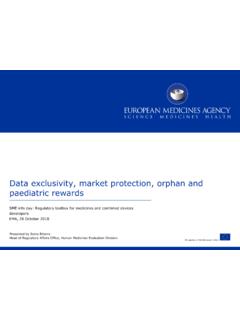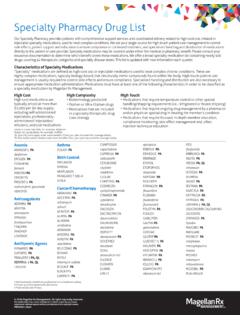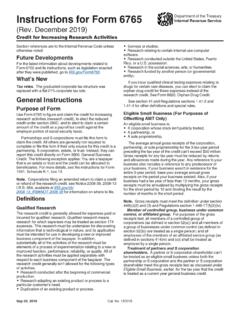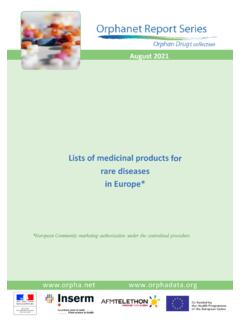Transcription of Pharmaceutical Reimbursement and Pricing in Germany
1 June 2018 Pharmaceutical Reimbursement AND Pricing IN Germany 2 Pharmaceutical Reimbursement AND Pricing IN Germany OECD 2018 Authors: Martin Wenzl and Val rie Paris This country profile was prepared to inform several OECD projects related to Pharmaceutical policies and was updated in June 2018. This country profile benefited from input and comments from the German Federal Ministry of Health. Authors remain responsible for any errors.
2 This work benefited from a financial contribution from the World Health Organisation. This document and any map included herein are without prejudice to the status of or sovereignty over any territory, to the delimitation of international frontiers and boundaries and to the name of any territory, city or area. OECD 2018 3 Pharmaceutical Reimbursement AND Pricing IN Germany OECD 2018 Table of contents List of abbreviations .. 4 Pharmaceutical Reimbursement and Pricing in Germany .
3 5 1. Contextual background - Health care system characteristics .. 5 2. Pharmaceutical Reimbursement and Pricing in brief .. 5 3. Pricing and Reimbursement : decision making process .. 7 Institutions, experts and stakeholders involved .. 8 Principles of assessment .. 9 Resolution .. 11 Price negotiations .. 11 4. 13 5. Negotiations and Pricing for inpatient hospital drugs .. 15 Annex - Guidance for assessment of the additional benefit of new product-indications .. 17 Sources and references .. 19 4 Pharmaceutical Reimbursement AND Pricing IN Germany OECD 2018 List of abbreviations AMNOG Law Reforming the Pharmaceutical Market (Arzneimittelmarkt-Neuordnungsgesetz) AMVSG Law Strengthening the Pharmaceutical Supply (Gesetz zur St rkung der Arzneimittelversorgung) G-BA Federal Joint Committee (Gemeinsamer Bundesausschuss) GKV-SV National Association of Statutory Health Insurance Funds (Spitzenverband Bund der Krankenkassen)
4 IQWiG Institute for Quality and Efficiency in Health Care (Institut f r Qualit t und Wirtschaftlichkeit im Gesundheitswesen) InEK Institute for the Hospital Remuneration System (Institut f r das Entgeltsystem im Krankenhaus) KHEntgG Law on Hospital Remuneration (Krankenhausentgeltgesetz) NUB New Diagnostic and Treatment Methods (Neue Untersuchungs- und Behandlungsmethoden) SGB V Fifth Social Security Code (F nftes Sozialgesetzbuch) SHI Statutory Health Insurance 5 Pharmaceutical Reimbursement AND Pricing IN Germany OECD 2018 Pharmaceutical Reimbursement and Pricing in Germany 1.
5 Contextual background - Health care system characteristics 1. Health insurance is mandatory in Germany . The vast majority of Germany s population (90%) get coverage from statutory health insurance (hereafter SHI). The other 10 % are covered by private insurance or special schemes. The basket of goods and services covered by SHI is defined at the national level by law, in terms of general principles, and the Joint Federal Committee (Gemeinsamer Bundesausschuss - G-BA), through decisions on individual products or services that should be excluded from or included in the basket).
6 Private health insurers generally cover a more or less similar basket though they are allowed to extend or restrict benefits (Paris and Docteur, 2008). 2. The basket of reimbursed pharmaceuticals is defined by the statutory exclusion of several categories of products, including OTC medicines, treatments for minor ailments and life-style medicines (see Paris and Docteur, 2008 for more details). Patients are generally required to contribute to the costs of pharmaceuticals through a 10% co-insurance rate (with a minimum of EUR 5 and a maximum of EUR 10 per prescription).
7 When products are included in reference price clusters, subject to a unique maximum Reimbursement amount, patients have to pay any difference between the market price and the maximum Reimbursement amount. Compulsory health insurance (statutory and private) covers 84% of the expenditure for outpatient medicines and patients pay the rest through co-insurance payments or consumption of OTC medicines. Medicines used in inpatient care are fully covered by health insurance. 2. Pharmaceutical Reimbursement and Pricing in brief 3.
8 Pricing and Reimbursement policies are based on the following principles: prescription drugs are reimbursed by health insurance unless included in a negative list maintained by the G-BA); manufacturers are free to set their price; drugs can be clustered in groups of products considered to be therapeutically equivalent and subject to maximum Reimbursement amounts. Since 2007, health insurance funds have been using calls for tender and contracting to obtain lower prices mainly, but not only, for generics.
9 Prices of innovative drugs are mainly negotiated. 4. The law reforming the Pharmaceutical market (Arzneimittelmarkt-Neuordnungsgesetz AMNOG), which took effect in January 2011, has kept the principle of free Pricing at launch but imposes a systematic and formal assessment of the 6 Pharmaceutical Reimbursement AND Pricing IN Germany OECD 2018 added therapeutic benefit of new medicines in order to negotiate the price according to the therapeutic value of the drug within twelve months after market launch.
10 If a new drug has some added therapeutic benefit over existing standards of care, a Reimbursement price is negotiated based on the prices of appropriate comparators (the current standard of care) between the national association of statutory health insurance funds (Spitzenverband Bund der Krankenkassen GKV-SV) and the Pharmaceutical company (see details below). If no additional therapeutic benefit is found, the new drug is included in a reference price cluster (Festbetrag) where possible. Otherwise, a price is negotiated that should not be higher than the price of the appropriate comparator.















